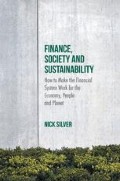Abstract
Chapters 2–5 have described the savings channel, where money is managed on behalf of savers by asset managers in capital markets. People also save through the deposit channel, which is the subject of this chapter.
More of this book deals with the savings than the deposit channel. The main reason, really, is because there are countless numbers of books on banks, the banking crisis and banking reform, by much more eminent people than myself, such as the former Governor of the Bank of England, the former chairman of the Financial Services Authority and the former Chairman of the Federal Reserve amongst others. Banks are where all the attention and effort has been directed in trying to fix the financial system. But the savings system is at least as important as banks. Large banks are almost entirely publicly listed companies; hence, their shares are ultimately owned by asset owners, with the ownership function delegated to professional asset managers, as described in Chapter 2.
Access this chapter
Tax calculation will be finalised at checkout
Purchases are for personal use only
Notes
- 1.
Noss, J and Sowerbutts, R (2012) The Implicit subsidy of banks Bank of England.
- 2.
Noss, J and Sowerbutts, R (2012) The Implicit subsidy of banks Bank of England.
- 3.
This represented the position of textbooks until relatively recently. The latest textbooks for example Sloman, J Garrett, D and Wride, A (2014) Economics Pearson; 9th Edition or Krugman, P and Wells, R (2015) Economics W.H.Freeman & Co Ltd; 4th Revised edition, still explain the money multiplier story but provide critiques of the theory. They also mention in passing that money is created by banks.
- 4.
The money multiplier is the inverse of the reserve ratio.
- 5.
Mcleay, M Radia, A and Thomas, R (2014) Money Creation in the modern economy Bank of England Quarterly Bulletin 2014 Q1.
- 6.
Werner, R (2005) New Paradigm in Macroeconomics Palgrave Macmillan.
- 7.
I could, though, create private money, from which I could only profit if I could persuade people to accept it.
- 8.
From Bank of England interactive statistics database data series LPQAUYM and LPMAVAA.
- 9.
For example, Werner, R (2005) New Paradigm in Macroeconomics Palgrave McMillan.
- 10.
From lecture by Richard Werner at Robinson College, Cambridge 30 October 2012 https://www.postkeynesian.net/downloads/Werner/RW301012PPT.pdf
- 11.
The Telegraph 6 November 2014 Full investigation into the dominance of “big four” UK banks confirmed.
- 12.
Bjerg, O Macfarlane, L Hougaard, R Nielsen Ryan-Collins, J Seigniorage in the 21st Century: A study of the Profits from money creation in the United Kingdom and Denmark CBS Working Paper
- 13.
McKinsey Global Institute (2015) Debt and (Not Much) Deleveraging McKinsey & Company.
- 14.
There are arguments for or against including financial sector debt. In theory, financial sector debt should net off, all the financial sector does is borrow from one party and lend to another, so including the finance sector would lead to double counting. On the other hand, some of the financial sector debt is outside of the UK. Also, if there is a crisis or downturn, the high finance sector debt will increase the economic damage.
- 15.
Financial Times 22 May 2015 Lenders pour cash into UK property market.
- 16.
Savills blog 15 January 2015 UK housing stock rises to £5.75 trillion http://www.savills.co.uk/blog/article/185397/residential-property/uk-housing-market-rises-to-5-75-trillion.aspx
- 17.
London Stock Exchange Statistics http://www.londonstockexchange.com/statistics/markets/markets.htm accessed 28 December 2016.
- 18.
For example, TSB Mortgage eligibility criteria http://www.tsb.co.uk/mortgages/guides/mortgage-eligibility-criteria/ accessed 28 December 2016.
- 19.
Buy-to-let mortgages represent around 10% of total mortgages; Council of Mortgage Lenders 14 February 2013 Buy-to-let lending £16.4 billion in 2012 ( https://www.cml.org.uk/news/press-releases/3423/).
- 20.
For example, TSB Mortgage eligibility criteria http://www.tsb.co.uk/mortgages/guides/mortgage-eligibility-criteria/ accessed 28 December 2016.
- 21.
Geanakoplos, J (2009) The Leverage cycle NBER Macroeconomics annual.
- 22.
Source: Office for National Statistics accessed 20 January 2017.
- 23.
BBC News 13 January 2015 Why can’t the UK build 240,000 houses a year? http://www.bbc.co.uk/news/magazine-30776306
- 24.
Frank J. Fabozzi, Franco P. Modigliani, Frank J. Jones (2015) Foundations of Financial Markets and Institutions (4th Edition) Prentice Hall.
- 25.
In 2014 International Capital Markets Association How big is the repo market? http://www.icmagroup.org/Regulatory-Policy-and-Market-Practice/repo-and-collateral-markets/frequently-asked-questions-on-repo/4-how-big-is-the-repo-market/ accessed 28 December 2016.
- 26.
Fiaschi, D Kondor, Marsili, M (2013). The Interrupted Power Law and the Size of Shadow Banking PLoS One 9(4).
- 27.
Palan, R. & Nesvetailova, A. (2014) Elsewhere, Ideally Nowhere: Shadow Banking and Offshore Finance Politik, 16(4), pp. 26–34.
Author information
Authors and Affiliations
Copyright information
© 2017 The Author(s)
About this chapter
Cite this chapter
Silver, N. (2017). A Kind of Magic. In: Finance, Society and Sustainability. Palgrave Macmillan, London. https://doi.org/10.1057/978-1-137-56061-2_6
Download citation
DOI: https://doi.org/10.1057/978-1-137-56061-2_6
Published:
Publisher Name: Palgrave Macmillan, London
Print ISBN: 978-1-137-56060-5
Online ISBN: 978-1-137-56061-2
eBook Packages: Economics and FinanceEconomics and Finance (R0)

